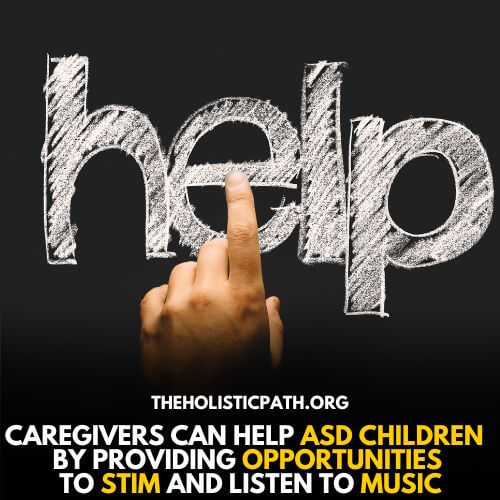Stimming is a self-stimulatory behavior characterized by repetitive or stereotyped movements, use of objects, or body posturing. Stimming often occurs in people with autism and other neurodivergent conditions. It can be a way to relieve boredom, cope with anxiety, or express feelings.
Stimming can also be a form of communication. Many stimmers find that music helps to regulate their stimming behaviors. In some cases, stimming behaviors may even be triggered by music. For many stimmers, music is an important part of their lives.
This article will explore the relationship between stimming and music, and how music can be used to help regulate stimming behaviors.
What Is Stimming?
Stimming is a short form for self-stimulatory behavior. Stimming refers to any repetitive action that someone does in order to stim, or stimulate themselves. Stimming can serve many purposes, including helping someone to focus or calm down.
Stimming can also be a way of expressing excitement or joy.
Some people stim by fidgeting with their hands or tapping their feet, while others may stim by making noises or humming to themselves. Stimming is often seen as a coping mechanism for people with autism or other conditions that affect social interaction and communication.
However, stimming is also common in neurotypical individuals, and is not necessarily indicative of any underlying condition. While stimming is often considered disruptive or strange, it can actually be a helpful way for some people to cope with anxiety or overwhelming sensations.
There are different types of stimming behavior, including:
- Auditory stimming: This is when a person stims by making noises, such as humming or singing.
- Tactile stimming: This is when a person stims by touching things, such as running their hands through their hair or rubbing their skin.
- Visual stimming: This is when a person stims by looking at things, such as spinning objects or staring at lights.
- Vestibular stimming: This is when a person stims by moving their body, such as jumping or spinning.
- Olfactory or taste stimming: This is when a person stims by smelling or tasting things, such as putting things in their mouth or sniffing objects.
Music Therapy
Music therapy is a type of therapy that uses stimming and music to improve the lives of those with disabilities. Stimming is the use of repetitive sounds or movements to soothe oneself, and music therapy uses stimming to help people with disabilities feel more relaxed and comfortable.
Music therapy can be used to help people with a wide range of disabilities, including autism, ADHD, and Down syndrome. Stimming can help to improve concentration, communication, and social skills. It can also help to reduce anxiety and depression.
Music therapy is an evidence-based therapy, which means that there is scientific research to support its effectiveness. If you are looking for a way to improve the quality of life for yourself or a loved one with a disability, consider music therapy.
Relationship Between Stimming And Music
Stimming is often considered a coping mechanism for people with autism spectrum disorder (ASD), as it can help to reduce anxiety and improve focus. Music can be a form of stimming for some people with autism.
Music, like stimming, can also be a coping mechanism for people with ASD.
Music can be used to regulate emotions, and the act of creating music can help to boost self-esteem and confidence. Music can be calming and help people with autism focus. Music can also be energizing and help people with autism get moving.
In addition, music can be a social activity that helps to build connections with others. Some people with autism find that they connect with music in a way that they don’t connect with other people or things. Music can be a form of communication for people with autism who struggle to communicate in other ways.
For many people with ASD, stimming and music are closely linked behaviors that offer important benefits.
Using Stimming And Music To Help People With Autism
Stimming and music are often used together to help people with autism. Stimming is a repetitive behavior that can be used to calm oneself or as a form of self-stimulation. Music, on the other hand, can be used to help regulate emotions and provide a source of entertainment.
When stimming and music are used together, they can help to provide a sense of routine and structure for people with autism. In addition, the combination of stimming and music can also help to reduce anxiety and improve mood.
Moreover, stimming and music can be used together to promote social interaction and communication. Finally, stimming and music can also help to provide a means of self-expression for people with autism.
Benefits Of Stimming And Music
Stimming and music both offer a wide range of benefits that can be extremely helpful for individuals on the autism spectrum. Stimming can help to regulate emotions and relieve anxiety, while music can improve communication skills and memory. Here are some more specific benefits of stimming and music:
- Stimming can help to reduce stress and anxiety levels, as well as providing a sense of calm and relaxation.
- Stimming can also help to increase focus and concentration.
- Music can help to develop communication skills, including nonverbal communication.
- Music can also improve memory, both short-term and long-term.
- Music can help to promote social interaction and bonding.
- Stimming and music can be used together to help people with autism by providing a repetitive and calming sensation.
- The two can be used separately or together to create a more positive environment for the person with autism.
- Both stimming and music have been shown to have positive effects on the brain, which can help people with autism to focus and learn new tasks.
Overall, stimming and music offer a variety of benefits that can be extremely helpful for individuals on the autism spectrum. If you or someone you know is on the autism spectrum, consider incorporating stimming and music into your daily routine.
How Can Parents And Caregivers Help Children With Autism To Stim And Listen To Music?
Music is a common passion for people with ASD. Listening to music can help stimming behaviors as well as provide a much-needed outlet for emotions. When stimming to music, it can be helpful to choose songs with a heavy beat or a fast tempo.

This can help to increase focus and concentration. Parents and caregivers can help children with ASD by providing opportunities to stim and listen to music. This can be done by creating a safe and accepting environment, offering stim toys and musical instruments, and listening to music together.
There are a few things that parents and caregivers can do to help children with autism to stim and listen to music:
- Create a calming environment: minimize distractions and provide a relaxing space for stimming and listening to music. This could include dimming the lights, using soft furnishings, and playing calming music.
- Encourage speech and communication: provide opportunities for the child to communicate their needs, wants, and thoughts. This could include using picture boards or sign language.
- Model appropriate behavior: demonstrate how to stim in a positive and constructive way. This could include showing the child how to use headphones or stim tools such as fidget spinners.
By following these tips, parents and caregivers can help children with autism to stim in a positive way and listen to music effectively.
Stimming And Music Therapy; A Hope For People With Other Disabilities
There is growing evidence that stimming can offer a number of benefits for those who engage in it. For example, stimming can help to regulate emotions, relieve boredom or anxiety, and provide a sense of control over one’s environment.
In addition, stimming can help to improve focus and concentration. As a result, stimming is often seen as a positive coping mechanism.
Music therapy is another intervention that can offer similar benefits for people with disabilities.
Music therapy involves the use of music to achieve individualized therapeutic goals. Like stimming, music therapy can help to regulate emotions, relieve boredom or anxiety, and improve focus and concentration. In addition, music therapy can promote social interaction and language development.
For these reasons, music therapy is an important treatment option for people with disabilities.
Tips For Incorporating Music Into Stimming Routines
When stimming, many people find that music can be helpful in providing a sense of rhythm and preventing stimming from becoming overwhelming. Here are a few tips for incorporating music into stimming routines:
- Find songs with calming rhythms: Listening to soothing music can help stimming become more rhythmic and less chaotic.
- Create playlists specifically for stimming: This way, you always have a go-to selection of stim-friendly songs on hand.
- Use music to set the mood: If you’re feeling particularly energetic, stim to some upbeat music; if you need to wind down, stim to something calming.
- Experiment with different genres: You may be surprised at how well certain types of music lend themselves to stimming.
Music can be a great way to make stimming more enjoyable, so don’t be afraid to get creative and experiment!
Stimming And Music Therapy: Some Of The Associated Risks
When it comes to stimming and music therapy, there are a few risks to be aware of. First, stimming can sometimes be overwhelming for the senses, which can lead to anxiety or panic attacks. It’s important to start slowly and gradually increase the intensity of stimming if you’re new to it.
Second, music therapy can sometimes trigger negative emotions, so it’s important to be in a safe and supportive environment while working with a therapist. Lastly, stimming and music therapy can sometimes cause physical reactions, such as increased heart rate and sweating.
Again, it’s important to start slowly and increase the intensity gradually to avoid any negative reactions. Overall, stimming and music therapy can be beneficial for mental health, but it’s important to be aware of the risks before getting started.
Some Songs Or Genres That Can Be Beneficial
There are no hard and fast rules about what kind of music is best for stimming, as different people will respond differently to different types of music. There are no rules about what kind of music is best for stimming, so it’s important to experiment and find what works best for you.
Some people find that fast-paced, energetic music is perfect for stimming, while others prefer slower, more calming tunes. There are no wrong answers when it comes to stimming and music – it’s all about what makes you feel good!

However, some suggested songs or genres that may be beneficial for stimming include classical music, nature sounds, or animal sounds. Experimenting with different types of music is a good way to find out what works best for you or your child.
Conclusion
Stimming is a great way to get your body moving and your energy flowing. It can also be a great way to connect with other people who share your love of music. When you stim, you’re not just moving your body – you’re also creating a soundscape that can be enjoyed by others.
Whether you’re stimming to the beat of your favorite song or making up your own tunes, stimming is a great way to express yourself and connect with others. So go ahead and let the music move you!
References
Greenberg, D. M., Baron-Cohen, S., Stillwell, D. J., Kosinski, M., & Rentfrow, P. J. (2015). Musical Preferences are Linked to Cognitive Styles. PLOS ONE, 10(7), e0131151. https://doi.org/10.1371/journal.pone.0131151
Li, J. J., Zhang, X. Y., Lu, H. T., Teng, W. J., & Liu, S. H. (2021). Positive effects of music therapist’s selected auditory stimulation on the autonomic nervous system of patients with disorder of consciousness: a randomized controlled trial. Neural Regeneration Research, 16(7), 1266. https://doi.org/10.4103/1673-5374.301021
